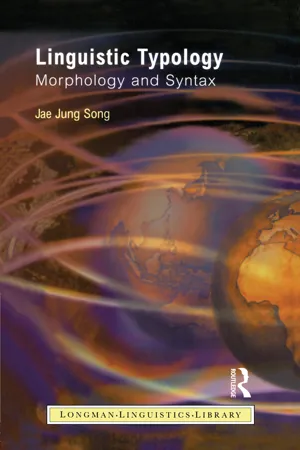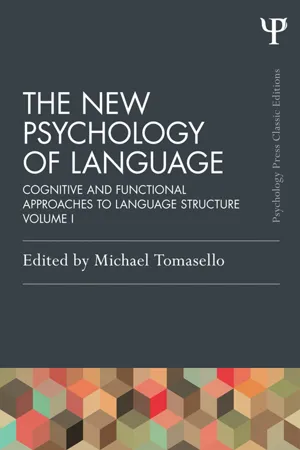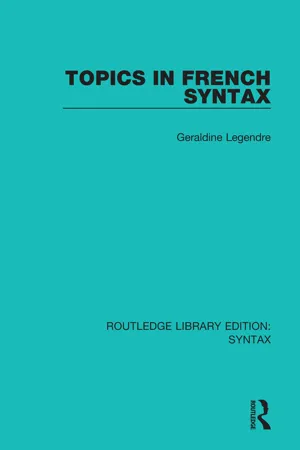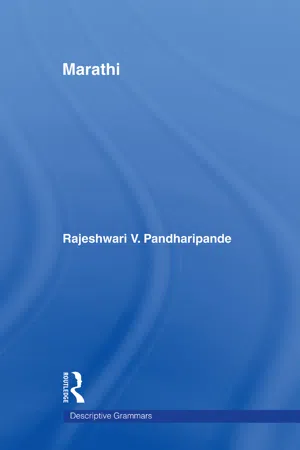Causative
In linguistics, a causative is a grammatical construction that indicates that one person or thing causes another to do something. It can be expressed through various linguistic devices, such as affixes, auxiliary verbs, or word order. Causatives are found in many languages and play a crucial role in expressing causation and agency.
6 Key excerpts on "Causative"
- eBook - ePub
Linguistic Typology
Morphology and Syntax
- Jae Jung Song(Author)
- 2014(Publication Date)
- Routledge(Publisher)
...5 Causatives 5.1 Introduction The Causative construction generally represents a linguistic expression which denotes a complex macro-situation consisting of two micro-situations or component events (cf. Nedjalkov and Silnitsky 1973: 1, Comrie 1989: 165–6): (i) the causing event in which the causer does or initiates something in order to bring about a different event (i.e. the caused event), and (ii) the caused event in which the causee carries out an action or undergoes a change of condition or state as a result of the causer’s action. The following English sentence thus denotes a Causative situation, for instance. (1) Elizabeth made the chef eat the leftovers. In (1), having the desire or wish to have the leftovers consumed, the causer (or Elizabeth) did (or said) something, and as a result of that action the causee (or the chef) in turn carried out the action of eating the leftovers, thereby satisfying the causer’s desire or wish. Note that in (1) the fact that the causer had had the desire or wish is not explicitly indicated at all but rather simply assumed to be antecedent to the causer’s action (see 5.9 for discussion). Further observations about the Causative construction can be made on the basis of the example in (1). First, the causer’s action is expressed by the predicate of cause made, and the causee’s action by the predicate of effect eat ; these predicates happen to be separate lexical verbs in (1). Second, the actual action performed by the causer, as opposed to the action performed by the causee, is highly ‘abtractized’ down to the simple expression of causation. In other words, ‘[a]U that is expressed by the predicate representing the causing event… is the pure notion of cause … without more specific lexical content’ (Kemmer and Verhagen 1994: 117). Third, the causer NP and the predicate of cause are ‘foregrounded’ in opposition to the causee NP and the predicate of effect...
- eBook - ePub
The New Psychology of Language
Cognitive and Functional Approaches to Language Structure, Volume I
- Michael Tomasello, Michael Tomasello(Authors)
- 2014(Publication Date)
- Psychology Press(Publisher)
...The syntax of a language provides a wealth of evidence in this regard—if we can find ways of analyzing this evidence in an illuminating and nonarbitrary way. I believe that here as elsewhere—and perhaps even more in this case—the key to such analysis lies in the choice of a suitable semantic metalanguage. In the existing literature on Causatives, the semantics of different constructions is usually discussed in terms of ready-made labels such as direct vs. indirect causation, contactive vs. distant causation, strong coercion vs. weak coercion, authority vs. absence of authority, factitive vs. permissive causation, or manipulative vs. directive causation (cf., for example, Comrie, 1974, 1985; Givón, 1975; Kachru, 1976; Ruwet, 1973/1976; Shibatani, 1973, 1976; Song, 1996; Talmy, 1976; Xolodovič, 1969). But labels of this kind are often more misleading than helpful and they don’t have much explanatory or predictive power, for the meaning of the constructions to which they are applied differs from language to language. Generally speaking, the common use of ready-made labels such as direct/indirect causation, contactive/distant causation, or strongly coercive/weakly coercive Causatives is based on the mistaken (in my view) assumption that there are certain types of causation that can first be described a priori, and then identified in individual languages. But detailed semantic analysis shows that the actual Causative constructions are usually rather unique in the meaning they encapsulate. What is called direct causation or strongly coercive causation in one language is usually different from what is called direct causation or strongly coercive causation in another. This is not to say that there are no recurring motives, no cross-linguistic similarities in the area of causation. Far from it. The point is that usually Causative constructions encapsulate a unique combination of components...
- eBook - ePub
- Shigeru Miyagawa(Author)
- 2012(Publication Date)
- Routledge(Publisher)
...This indirect causation cannot simply be in the form of, for example, ordering/directing an embedded agent/force to do something. Rather, one must employ some special method for indirectly bringing about the event. On this analysis, there is nothing special about the analytical-Causative forms in (41); they are precisely what we expect of an analytical Causative built on an unaccusative verb, and there is no reason to treat them in some special manner. 8 CONCLUSION The Causative forms in Japanese give support to the idea that both lexical and analytical Causatives share a common syntactic frame, where a Causative v selects a maximal projection: v P, VP, PP, AP, NP. If v CAUSE selects a v P, the result is an analytical Causative, while any of the other XPs results in a lexical Causative (Hale and Keyser 1993). We saw that this v CAUSE may be pronounced by the same morpheme in both the lexical Causative and the analytical Causative: - sase in Japanese and make in English. Where there is a specific (synthetic) lexical Causative, it blocks V- sase from being idenjpgied with the lexical Causative, so that it cannot participate in any lexical-Causative processes such as idiomatization and the double-Causative construction. While these cases of Causatives in English and Japanese are amenable to a derivation-based approach to blocking, there are cases in the literature that have been analyzed on a filter-based approach. We saw that these, too, are compatible with a derivation-based analysis, making the filter-based approach to blocking unnecessary....
- eBook - ePub
Causatives and Causation
A Universal -typological perspective
- Jae Jung Song(Author)
- 2014(Publication Date)
- Routledge(Publisher)
...One can easily argue for the opposite direction of change, i.e. from Causative to directive (not to mention why the dative-directive affix is used in addition to the Causative affix). What is lacking in his account is an independent parameter to determine the direction of change. The universal typology of Causative constructions in Chapter 2 provides such a parameter, because it clearly indicates the direction of change regarding these two functions: from directive to Causative. It is in Givón (1971a) that the linguistic archaeologist’s manifesto quoted earlier is promulgated. Givón outlines with a great deal of plausibility how independent lexical elements may change into affixes. Although he discusses Causative affixes originating primarily from higher lexical verbs ‘to cause’ or [Vcause], his main concern is to establish the correlation between word order, on the one hand, and prefixes and suffixes, on the other. In OV languages, lexical Causative verbs become suffixes, whereas in VO languages, they become prefixes (see Figure 3.1 and Figure 3.2 ; both are taken from Givón 1971a). 1 Thus, Givón (1971a: 412) demonstrates that one primary source for Causative affixes is lexical verbs of cause, although he does not indicate what other nonprimary sources of Causative affixes there may be. Comrie (1981a [1989]: 176) cites in passing as evidence for the Causative affix as an indicator of increase in valency (due to the introduction of the causer; see 6.2) the fact that in many languages the same morphology is used in both morphological causativization and ditransitivization of monotransitive verbs...
- eBook - ePub
- Geraldine Legendre(Author)
- 2016(Publication Date)
- Routledge(Publisher)
...V Causative Unions 5.1. Introduction Causative contractions have been a very fruitful area of syntactic research over the last fifteen years. French Causative constructions in particular have received much attention from various theoretical perspectives. Important studies include Ruwet (1972), Perlmutter and Postal (1974), Kayne (1975), Radford (1978), Aissen (1979), Rouveret and Vergnaud (1980), Quicoli (1980, 1981, 1984), Postal (1981, 1983a, 1984), Zubizarreta (1982), Fauconnier (1983), Rosen (1983, 1984a), Burzio (1986), Gibson and Raposo (1986), Davies and Rosen (1988). Within RG, the most comprehensive analysis of Causative constructions cross-linguistically is due to Gibson and Raposo (1986). Their typological study includes an account of French Causatives which appeals to both universal principles and a language-particular rule. In essence, they claim that Causative constructions obey a language-particular principle governing the embedded subject and a universal principle governing all other arguments of the embedded clause. The purpose of this chapter is to refine Gibson and Raposo's analysis of French Causative constructions. While the present analysis keeps the fundamental insights provided in Gibson and Raposo (1986) - the interaction between universal and language-particular principles, as well as the formulation of the universal principle itself - it argues for a reformulation of the language-particular rules which govern French Causative constructions. In particular, it is claimed that the embedded 1 always revaluates to 3 in French. Because the proposal made in this chapter involves a fair amount of technical detail, I delay its more precise characterization until after the standard RG conception of Causative constructions has been presented. The chapter proceeds as follows. In section 5.2, I briefly review the RG analysis of Causative constructions known as the Union analysis...
...In fact, this is the most productive process of forming Causatives in Marathi. Causatives from vowel-ending verbs (except for deṇe ‘to give’ which allows Causative to be formed by either process) are coercive periphastic Causatives. The process of forming Causatives by adding - aw is blocked in this case. Examples are given below. (1174) Verb stem Causative khā ‘eat’ khāylā lāwṇe ‘to make eat’ *khāwṇe/*khāwawṇe ye ‘come’ yāylā lāwṇe ‘to make come’ *yāwṇe/*yewawṇe dzā ‘go’ dzāylā lāwṇe ‘to make go’ (pāṭhawṇe ‘to send#x2019;) dhu ‘wash’ dhuwāylā lāwṇe ‘to make wash’ *dhuwawṇe 2.1.3.1.3.2 Agentivity of the causee Agentivity is crucial for determining case-assignment in Causative sentences. As is evident from the examples in section 2.1.3.1.3.1.1, the causee is generally an agent. It is important to note here that direct vs. indirect agency of the causee in carrying out the act expressed by the verb is indicated by the suffix/postposition. For example, if the agency of the causee is direct, then the causee takes the accusative suffix - lā or the instrumental postposition kaḍūn ‘by’. The indirect agency of the causee is indicated by the postposition dwārā ‘through’ as in (1175). (1175) mī mohan (tSyā) dwārā kām I Mohan (poss) through work-3sn karawle-3sn do-caus-pst-3sn ‘I got the work done through Mohan.’ (For further discussion on the syntax and semantics of postpositions in Causatives, see Pandharipande 1981a.) It is crucial to remember that the causee’s agency or ability (to carry out the act expressed by the verb) is implied in a Causative sentence. The postpositions - lā, kaḍūn, and dwārā indicate that the causee is the agent (direct or indirect) of the act. However, when the causee is non-volitional (either because it is inanimate or lacks control of the action (i.e., she/he is merely an experiencer)), the above postpositions are blocked and the verbs do not undergo causativization...





